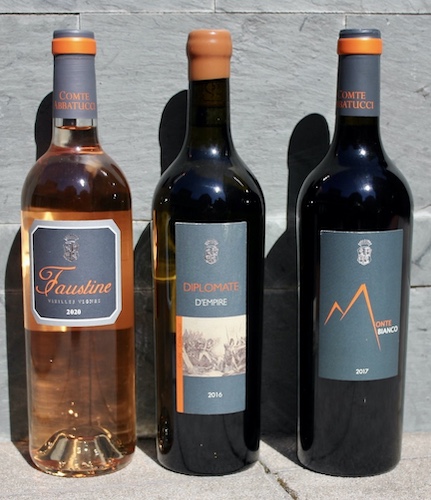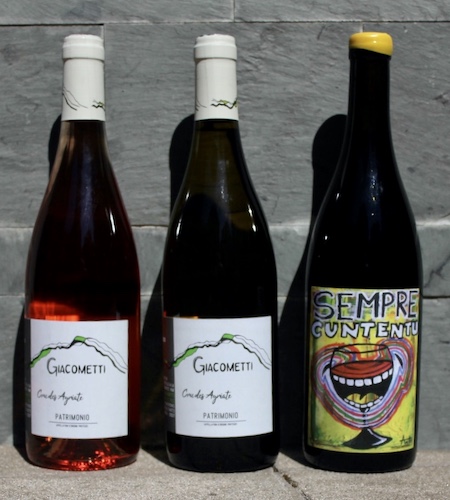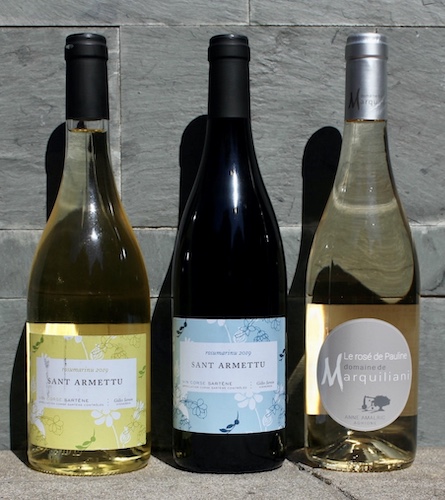On a sunny afternoon not long ago, four of us gathered in a Berkeley backyard to sip and sup and suss the singular case of Loire Valley chenin blanc. “What’s up here?” we asked ourselves. “What do these wines bring to the table, and how do we perceive and enjoy them in the pantheon of French and world white wines?”
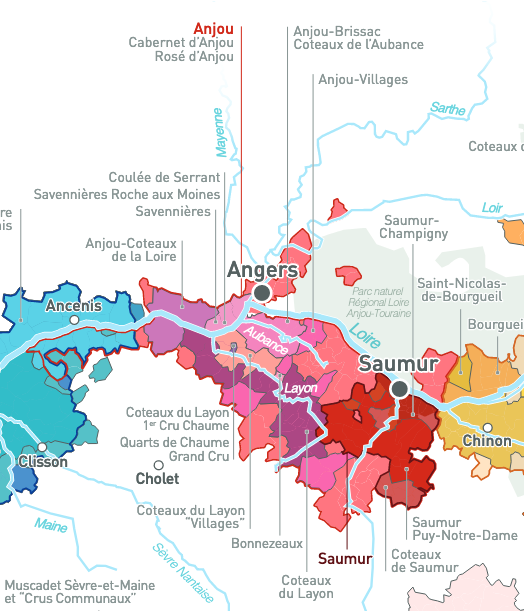 As we settled in, we mused on chenin’s relationship to two other great white wines of France: Champagne and white Burgundy. Loire chenin blanc, we realized, serves less often as a celebratory or special-occasion wine, and we wondered why that is.
As we settled in, we mused on chenin’s relationship to two other great white wines of France: Champagne and white Burgundy. Loire chenin blanc, we realized, serves less often as a celebratory or special-occasion wine, and we wondered why that is.
Champagne… OK, we all get it: The Champenois have spent generations cementing their wine’s reputation as the archetype of celebration. As for Burgundy, we agreed that great Loire chenin blanc shares two significant qualities with chardonnay: viscosity and grandeur. But if white Burgundy is the marble staircase rising in the foyer, chenin blanc is perhaps the hand-wrought, curving, Gaudi-esque iron flight. To move the analogy to Mount Everest: It’s, say, Edmund Hillary’s months-long, oxygen-tank-carrying siege up the South Col in 1953 compared to Reinhold Messner’s 1980 solo without oxygen. Both successful, and both with unobstructed views, but the routes and tactics differed greatly.
Another complicating curve of chenin blanc is the historical question of dryness and sweetness. Chenin blanc is one of those remarkable grape varieties that’s capable of making almost any kind of wine, from teeth-rattlingly dry to unctuously dessert sweet, not to mention sparkling. (The Loire Valley is France’s second-largest producer of sparkling wines, after Champagne.) The old-school Loire chenin blanc style is demi-sec (off-dry), balanced by chenin’s prominent acidity, but the current trend is drier, and all of the wines that we discuss here are dry.
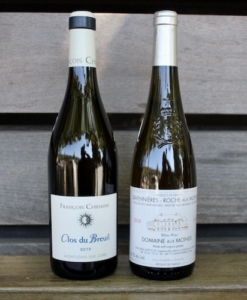 Our first flight included current vintages of two longtime PMW denizens: the 2019 François Chidaine Montlouis ‘Clos du Breuil’ ($39) and 2018 Domaine aux Moines Savennières ‘Roche aux Moines’ ($42). Both were as comfortable as a favorite, old wool sweater. “Wooliness,” of course, is a common descriptor for the texture and lanolin notes of richer chenin blanc. “Honeyed minerality” and “wet concrete in November” also fit the bill. Yes, there’s a richness of fruit and mouth feel, but it’s tempered by chenin’s minerality and big-time acidity. One might also notice the red-fruit flavors in some of these wines. (Funny how that can happen in white wines!)
Our first flight included current vintages of two longtime PMW denizens: the 2019 François Chidaine Montlouis ‘Clos du Breuil’ ($39) and 2018 Domaine aux Moines Savennières ‘Roche aux Moines’ ($42). Both were as comfortable as a favorite, old wool sweater. “Wooliness,” of course, is a common descriptor for the texture and lanolin notes of richer chenin blanc. “Honeyed minerality” and “wet concrete in November” also fit the bill. Yes, there’s a richness of fruit and mouth feel, but it’s tempered by chenin’s minerality and big-time acidity. One might also notice the red-fruit flavors in some of these wines. (Funny how that can happen in white wines!)
We also noted the vineyard names on the label (Clos du Breuil and Roche aux Moines). As with other noble varieties–like riesling, pinot noir, chardonnay, and nebbiolo–chenin blanc offers a great transparency to the land in which it grows, and the middle Loire Valley is a fascinating puzzle of soil types and slope exposures. These wines are a vinous ticket to exploring chenin terroir.
For our second flight, we visited Anjou, the wine appellation named after the medieval province centered on the beautiful, historic city of Angers. We pulled out two nine-year-old wines from Loire biodynamic grower and superstar Thibaud Boudignon: a 2012 Anjou Blanc and 2012 Anjou Blanc ‘a François(e).’ Both are testaments to the age-worthiness of Loire chenin blanc, with ‘a François(e)’ being the richer and more powerful cuvée, made from grapes from Thibaud’s best plots in Anjou. Any fan of any age-worthy white wine–Burgundy, riesling, or otherwise–would be happy to drink and proud to serve wines like these from her or his cellar (and, be it noted, at a significantly lower price than white Burgs of similar quality). These two wines were almost a decade old, but they and other serious chenin blancs can age effortlessly for multiple decades.

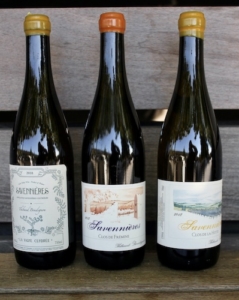 Although the 2012s are long gone, fear not: We have in stock the 2018 Boudignon Anjou Blanc ($45) and 2017 Boudignon Anjou Blanc ‘a François(e)’ ($75). Like so much white Burgundy and Champagne, these wines are beautiful now, but will handsomely repay aging in your cellar if you’re so inclined. (We also have Boudignon’s three magisterial bottlings of 2019 Savennières: ‘La Vigne Cendrée,’ ‘Clos de Frémine,’ and ‘Clos de la Hutte.’)
Although the 2012s are long gone, fear not: We have in stock the 2018 Boudignon Anjou Blanc ($45) and 2017 Boudignon Anjou Blanc ‘a François(e)’ ($75). Like so much white Burgundy and Champagne, these wines are beautiful now, but will handsomely repay aging in your cellar if you’re so inclined. (We also have Boudignon’s three magisterial bottlings of 2019 Savennières: ‘La Vigne Cendrée,’ ‘Clos de Frémine,’ and ‘Clos de la Hutte.’)
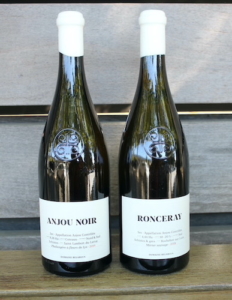 Our newest chenin blanc discovery is Domaine Belargus, a new Loire Valley estate with a single focus on chenin blanc and its different terroirs in the mid Loire Valley, including Anjou. (“Belargus” is a rare species of brilliantly blue-winged butterfly that inhabits the vineyards.) We have the 2019 Domaine Belargus ‘Anjou Noir’ ($36) (the “Noir” refers not to the color of the grapes, but to the dark color of the schist-and-shale-rich soils in the western half of the Anjou appellation) and the 2018 Domaine Belargus Anjou ‘Ronceray’ ($57), from seven tiny vineyard plots surrounding the Ronceray Abbey. This is most certainly a domaine to investigate now, before collectors get on board and drive up prices.
Our newest chenin blanc discovery is Domaine Belargus, a new Loire Valley estate with a single focus on chenin blanc and its different terroirs in the mid Loire Valley, including Anjou. (“Belargus” is a rare species of brilliantly blue-winged butterfly that inhabits the vineyards.) We have the 2019 Domaine Belargus ‘Anjou Noir’ ($36) (the “Noir” refers not to the color of the grapes, but to the dark color of the schist-and-shale-rich soils in the western half of the Anjou appellation) and the 2018 Domaine Belargus Anjou ‘Ronceray’ ($57), from seven tiny vineyard plots surrounding the Ronceray Abbey. This is most certainly a domaine to investigate now, before collectors get on board and drive up prices.
So there you have it–chenin blanc produces electric wines in a great breadth of style, flavor, and complexity, and, as our sunny backyard tasting proved, it’s a grape that inspires equally crackling conversation.
*****
To encourage you to join us in our chenin blanc explorations, we’re offering 15 percent off any six bottles of chenin blanc through the month of August. Besides the wines we mention in this article, we have lots more on our shelves, ranging from $20 to around $200 for the rarest of them all, so please ask us for recommendations. We are all deeply excited about the noteworthy chenin blancs we have right now, and we’d love to share them with you.
by Chad Arnold and Mark Middlebrook

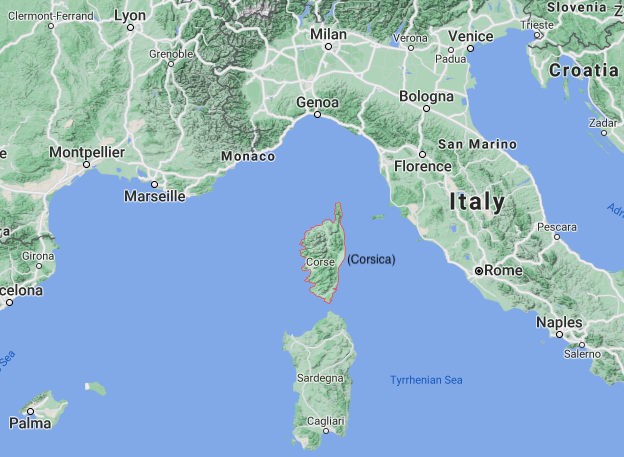
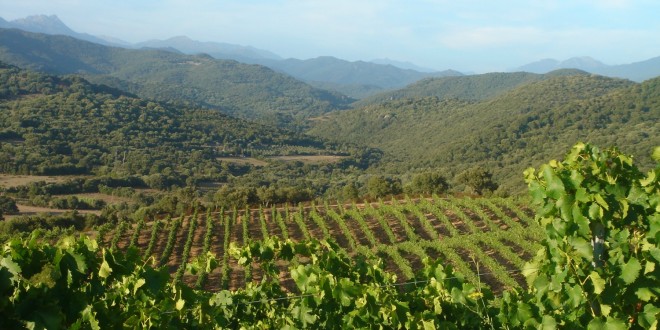 Abbatucci vineyards in Ajaccio.
Abbatucci vineyards in Ajaccio.